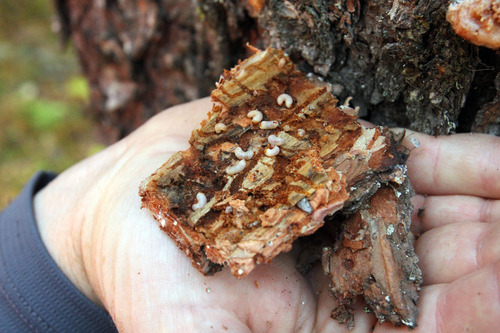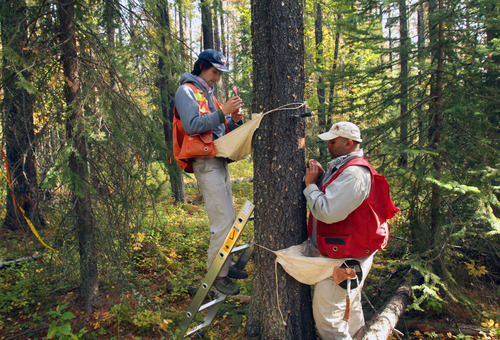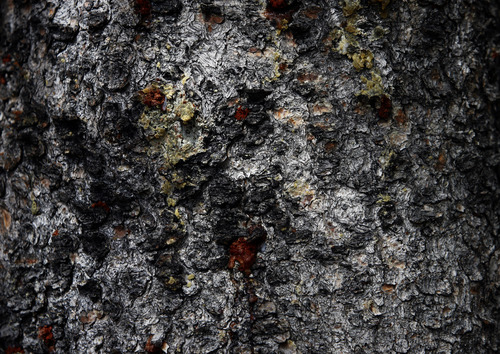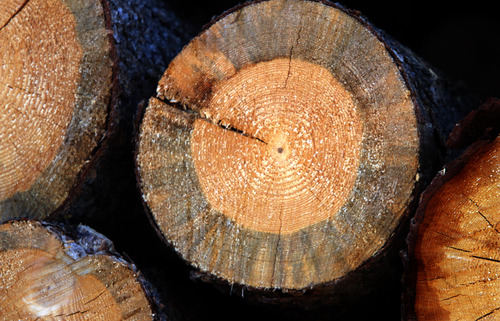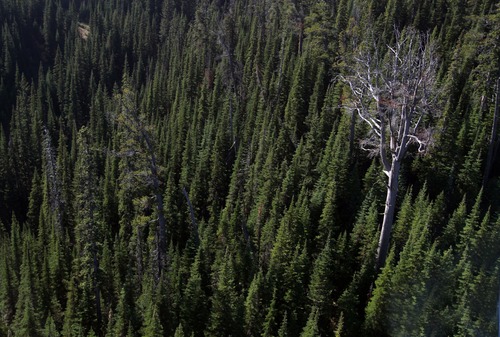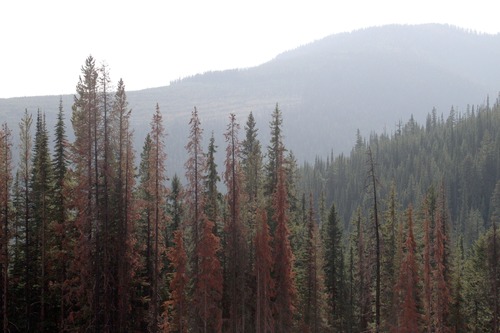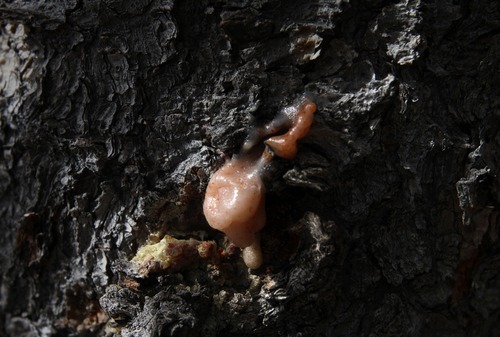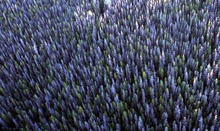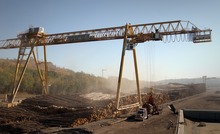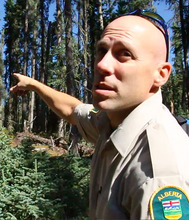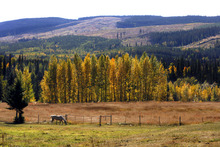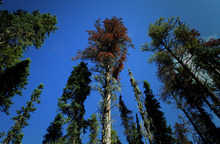This is an archived article that was published on sltrib.com in 2012, and information in the article may be outdated. It is provided only for personal research purposes and may not be reprinted.
Slave Lake, Alberta • Billions of tree-munching beetles rained on hayfields, bogs and forests here six years ago, tiny paratroopers riding strong winds and a warming climate to a new front in the age-old struggle between parasite and pine.
Here was virgin ground for the pests, and easy pickings.
After the Tic Tac-size beetles survived three of north-central Alberta's now-milder winters and then caught a still-larger wave of reinforcements riding 300 miles on summer winds from British Columbia, scientists knew the game had changed.
Like the bark beetles that have killed millions of trees in Utah and the American West — an eruption that began in 1997 — these mountain pine beetles exploded from a sickly tangle of evergreens. Trees grew old and dense from a century of quick-response firefighting. From there, climate change helped the invaders settle into new territories.
Now the East Coast's back door is wide open. Bugs, once blocked by a virtual wall of winter, today inhabit part of a northern band of pines that stretches unbroken across the continent before dipping into the U.S. and down the Eastern Seaboard. They could jeopardize forests from Maine's white pines to Georgia's loblollies.
"As long as the climate continues to ameliorate [for beetles]," said Allan Carroll, University of British Columbia insect ecologist, "they will keep going till they run out of pine."
In the Clear Hills, a few hours northwest of Edmonton, they've already run out. The area retains a mix of aspens and spruces, so a forested patchwork remains. But provincial foresters acknowledge they were wrong when they assumed the fading cold would aid them that far north and that the beetle invasion would fizzle. They directed their efforts at removing infested trees to the south, around the mill town of Grande Prairie, and now essentially every mature Clear Hills pine is dead, showing either red needles or bare gray limbs.
The town of Worsley's community ski hill, Whispering Pines, is suddenly misnamed. Volunteers cut a new run through dead trees.
Bill Basnett, an 82-year-old barley farmer who has lived there as long as some of those trees, didn't know what had hit when the 20 pines lining his driveway started turning red. His son had transplanted them from the surrounding forest half a century ago, and his wife, who died soon after the 2006 infestation, was heartbroken.
"We didn't have a clue. Kept spraying it, but it didn't help.
"It bothered her," the widower said of his wife while stroking one of three no-name cats that share his farm. "She liked a nice yard."
Her dead trees still stand, scruffy monuments to Alberta's new normal.
Feast to the east
How far east will the bugs go? The boreal forest that now marks the battle line at Slave Lake extends across the northern plains to Ontario, where it infiltrates a number of pine species whose veins stretch into America's Upper Midwest and Northeast before diving through pine plantations down the East Coast.
Much is at stake, economically and ecologically, even if few think about it.
"That would be a serious issue. You'd have people up in arms," said Jameson French, president of Northland Forest Products in New Hampshire.
French's company makes its living from the hardwoods for which New England's fall colors are celebrated. But similarly important to his region's economy and environment, he said, are the Eastern white pines — "our single most prominent tree."
He works with conservation associations and believes climate change's effects on forests are underappreciated. But even after visiting Colorado's graying mountains in the wake of the pine beetle assault, French hadn't realized the insect could move beyond the West's lodgepoles into other pines.
Reached by phone on a day when he was showing U.S. Senate staffers how the Northeast's warming climate is stressing trees and aiding pests such as the emerald ash borer, French said businesses and landowners need to wake up.
"I don't think there's been any conversation at all about this beetle," he said, "or the chances of it coming here."
There should be, warned Ken Raffa, a University of Wisconsin entomologist. His study of pines native to the Badger State suggest some use chemical defenses — the toxins they create to repel an endemic pine engraver beetle — that may actually worsen the assault from mountain pine beetles. Compared to Western lodgepoles, he said, these pines seem to have more of the chemical compounds that mountain pine beetles use to create a pheromone that helps attract more beetles to the tree.
"We certainly are alarmed," Raffa said, "that the chemistry may not have what it takes to defend itself against mountain pine beetles."
No one knows for sure how quickly the beetles could cross the continent's midsection, he said, but Eastern timber growers should consider breaking up species and age classes to prevent a disaster.
Northern exposure
Carroll expects the range expansion to continue because of what he has seen in Canada — almost unthinkable for most foresters just five years ago. Where once the insects petered out around Prince George in central British Columbia, now they kill trees 400 miles to the north, verging on the Yukon and Northwest Territories and massing for a subarctic surge through the lodgepoles all the way to bare tundra.
Where once the Canadian Rockies provided an eastern bulwark — a temperature barrier beyond which continental winters routinely locked in at 40 below Celsius — now such cold snaps are rare. Likewise, U.S. and Canadian forest scientists say, lengthening and warming growing seasons have stressed trees and boosted beetles.
Having adjusted to places where average winter lows are a few degrees warmer than they were a generation ago, the bugs are finding lodgepole lineages that apparently did not evolve defenses against them. These new hosts secrete less toxic pitch to encase and repel boring insects, Carroll said, and it takes fewer insects to kill the trees.
Canada is spending hundreds of millions of dollars to slow the advance of a native species that is acting increasingly like an invasive pest.
Slave Lake is where lodgepole pines hit their eastern frontier and hybridize with jack pines, svelte trees of similar stature but with sometimes crazier, spiraling limbs. The two pines can be hard to tell apart and, until last year, no one was sure whether the beetles might be killing the hybrids or, more ominously, the pure jacks that spread all the way to the East.
The jack pine's bark is thicker, and the phloem — the sub-bark, nutrient-conducting layer where beetles set up house and effectively choke off life — is thinner than a lodgepole's. It was unclear how beetles would fare. Could the jack pine provide a lifesaving buffer for Eastern forests?
Dale Thomas, a provincial forest health officer whose job description had nothing to do with beetles before 2006, suspected they were killing jack pines. He hacked into bark from trees that he believed were pure jacks and found wriggling white larvae.
"They were in there doing just fine," he said.
Thomas sent samples from afflicted trees to a University of Alberta lab for genetic testing.
From her lab desk overlooking the North Saskatchewan River and Edmonton's skyline, biological sciences research associate Catherine Cullingham ground needles to powder and added chemicals to isolate the DNA: pure jack pine. Her published results led to a collective national gasp — and to $450,000 this year from Saskatchewan to help Alberta slow the beetles' advance.
Now she is working to identify genetic markers of pines that may be unusually resistant to the insects, a potential holy grail for foresters hoping to plant commercially dependable stands or even replenish threatened species such as the alpine whitebark pine, which is vanishing from the Rockies as far south as Yellowstone and Grand Teton national parks.
It's a long-term solution for which the beetles may not wait, but Cullingham believes Canada's heightened awareness may shake loose research dollars.
"Before," she said, the pine beetle "was always seen as B.C.'s problem. It's been there for thousands of years and it's always been B.C.'s problem. Now that it's in the boreal, it's the country's problem."
Hand-to-tree combat
In the spongy green muskeg east of Lesser Slave Lake last month, Thomas walked under dying jack pines he previously had surveyed from the air. Red trees viewed from above become GPS marks on a map — evidence that there's likely fresher death on the ground.
Trees usually take at least a year from attack to turn red, so it's up to Thomas and his contractors to cruise these stands for new damage. Every scarred adult tree within 50 meters of the GPS mark is flagged for chain-saw removal before its occupant beetles can fly and attack again next July. Crews will pile and burn these trees in the winter snow.
It's a hands-on approach that wouldn't do in the uniform pine forests west of the Rockies, where it's hard to find uninfested trees. It's also more aggressive than the U.S. Forest Service's approach in the Rockies, where finite federal dollars have limited the agency to treating popular recreation sites — often by contracted thinning or expensive chemical applications.
But here, where grizzlies roam a gently rippling mosaic of pines, aspens, scraggly spruces, blueberries and red bunchberries, Alberta hopes to work with the landscape to slow the bugs. From the air in fall, this forest's calico color pattern suggests more hurdles for the beetle to negotiate than it found in the greener expanses of B.C. or the western U.S.
Foresters' idea is to slow the spread until the area catches a well-timed cold snap, perhaps early some fall, before the beetles have brewed their natural winter antifreeze. Thanks to oil money, Canada's richest province has an arsenal for the task, including contract helicopters to deliver slash-and-burn crews.
"We're buying time for Mother Nature to come and help us out, and for industry to get in and take some out," Thomas said. "But [the beetles] are here for good."
Mountain pine beetles historically took two years to develop from egg to adult attacker in colder ranges, whether on the northern fringes or high up in Utah and Wyoming. Here, though, Thomas has yet to notice an invasion that didn't lead to fresh attacks the next year.
It's a phenomenon Barbara Bentz, entomologist for the U.S. Forest Service's Rocky Mountain Research Station in Logan, has documented across Western cold spots. She reads thermometers inserted under the bark in places such as Togwotee Pass, Wyo., northeast of Jackson Hole. Then she watches for beetles to emerge into screen traps tacked to the trunk.
The proportion emerging in one year is increasing at high-elevation sites, she said. At others, parent beetles that normally would die after one attack emerge early the next spring to strike again.
"Even a few degrees can really make a difference for them," Bentz said.
Canadian Forest Service researcher Kathy Bleiker returns to pine stands near Grande Prairie every year to see how the beetles are coping. One cold blast last winter made clear the thin line between life and death.
At minus-34 Celsius, the insects wintered snugly under the lodgepole bark and came back strong in the summer. Arriving at her plot an hour south of town last month, she saw the fresh attacks to be surveyed and considered herself "a kid in a candy store."
"You had two decent winters here for the beetle," she said, "and I think you can see the result."
But at a stand eight miles away, her sensors tracked winter lows of 40 below. Every beetle died. At still another, minus 38 left mixed results.
Average annual temperatures have risen by 4 to 6 degrees Fahrenheit across the West since the 1970s. In the high country, including Utah's Brighton Ski Resort, according to data crunched by the Utah Climate Center at Utah State University, the same goes for average winter lows. That's a reflection of fewer deep freezes.
Carroll, at the University of British Columbia, noted that scientists on the Intergovernmental Panel on Climate Change project greenhouse-gas trends will lift temperatures by another 4 degrees or so in Canada's boreal forest by century's end.
That means the beetles will persist at some level despite control efforts, he said, and will earn more chances to ride the jetstream east. He doesn't believe Michigan and Wisconsin will see the infestation this decade, but he does advise foresters there to prepare.
"Mountain pine beetles will spread through the boreal forest," he said. "I absolutely think that's a guarantee."
Logging for life
More troubling to Alberta is the beetle's potential to head south from Grande Prairie along the eastern flank of the Rockies.
There, beginning east of Jasper National Park, "We have carpets of pure pine," said Erica Samis, senior forest health officer for the Alberta Ministry of Environment and Sustainable Resource Development.
If those carpets fast-track the beetles' advance, she said, headwaters of the province's major rivers could lose their natural filtration. The resulting gush of dirty spring runoff in the Bow River, for instance, could overwhelm the drinking water treatment capacity for a million people in Calgary.
The province has put up $296 million in Canadian dollars to fight beetles since 2004, and this year will spend $30 million. At first the effort was directed at far-southern sites, just north of Montana, where periodic beetle incursions were nothing new. In recent years, Alberta has aimed most of its money at the novel northern explosion.
So far, so good in aggressively protecting the watersheds. But Samis said nothing — including the boreal forest's richer mix of tree species — is likely to halt the eastward march. "There are no longer any barriers to the spread across Canada," she said. "We're not assuming that it's going to slow by any measure."
Timber companies, including U.S. giant Weyerhaeuser and Canadian leader Canfor, have been eager to help. Each has a renewable 20-year contract to log and care for a vast swath of Alberta's public "crown" forests and has altered its plans to slash the older pines that worry the province. Spruces, the more valuable species, are mostly on hold.
"Virtually everything we harvest today is either infested or at-risk pine stands," said Rick Watson, forest resources manager for Weyerhaeuser's Grande Prairie operations.
Weyerhaeuser has dual mills producing lumber and pulp for sanitary products. On 2.7 million acres that the company controls, 85 percent is coniferous forest — and more than half that is pine. The mills, employing 625 workers and 500 logging contractors and truckers, are processing 2 million cubic meters of wood a year — half a million more than they would have if not for the beetle war. The timber supply is projected to fall back to 1.3 million cubic meters by 2019, a slight dip from pre-outbreak projections.
The company focuses its efforts on stands that are at least 60 percent pine.
"We're doing everything we can do," Watson said. "However, at the end of the day, how well the beetles do and how they progress across the land is really a function of climate."
Mill manager Jason Trenn said aggressively "sanitizing" the forest is more effective in Alberta than in central British Columbia, where winter lows are typically warmer. He worked as a B.C. forester in 1997, when the beetles "exploded and overran us," he said, and his work planning virtual clear cuts proved futile.
"You thought you were making a difference," he said. "You quickly realized this is Mother Nature."
'War on the woods'
Canfor forester Jim Stephenson also moved from B.C. to Grande Prairie just ahead of the beetles and has focused his company's logging in areas with 80 percent mature pines. That's what the government said was susceptible, though Stephenson said the massive wind-borne invasions have helped beetles attack even isolated pines.
"Here in Alberta," he said, "the pattern was [beetles] dropped out of the sky by the billions."
The province asked Canfor to remove 75 percent of its susceptible, aging pines. It's a massive 15-year undertaking, producing some public backlash and a debate about how to do it while protecting regionally rare species such as caribou and bull trout.
Still, logging live pines now — and salvaging dead pines before they crack or rot — is vital to the future timber supply. Wherever Canfor harvests, it replants.
"It's better than letting [the forest] die," Stephenson said. "If you harvest it, it recovers more quickly."
Some Canadian environmentalists agree it's important to protect watersheds, but the Alberta Wilderness Association opposes logging on such a scale. The province is trying to "liquidate" forests wherever the beetle goes, said association Vice President Cliff Wallis.
Agreements to protect old-growth areas for caribou are frequently ignored, he said. "They call it a war on beetles. We call it a war on the woods."
In western Canada, mountain pine beetles have chewed through more than 42 million acres in this outbreak, mostly in the past decade. That represents a largely deforested, partially replanted blob the size of Florida and covering about as much ground as all beetle species — including pine, fir and spruce beetles in Utah — have denuded in the western U.S.
In British Columbia, many blame wilderness protection. The Tweedsmuir Provincial Park, a sprawling reserve along the Coast Range, was perhaps the biggest beetle reservoir that loggers couldn't touch as the outbreak began.
"The government of the day said, 'No you're not,' " said Fred Taylor, a retired aluminum smelter who lives in Quesnel, B.C. "This is a model of what politicians can really f—- up when they try."
Taylor meets a gang of retired loggers and truck drivers routinely for coffee at the Quesnel Flying Club next to the airport serving the city of 20,000. One of his friends, Richard Armstrong, said forest companies share the blame because they waited too long to cut pines.
"Even when we were logging it [20 years ago]," he said, "it was about as mature as you want to get. It was inevitable that something was going to take them out."
In fact, 20th-century economics played a key role. Until the 1970s, practically no one used central B.C.'s lodgepole pines. Lumber mills were busy raking in money on larger spruces and firs, leaving the pines untouched until the government encouraged their use.
Decades of fire suppression created "a banquet for the pine beetle," said Kathy Lewis, University of Northern British Columbia ecosystem science professor. "We weren't replacing the lack of fire with harvesting."
But pine is big business now, so much so that regional mills have invested millions in digital scanners and software that, in a split second, read the cracks and blue fungal stains caused by beetle kills and flip logs whirring by on conveyors into positions likely to maximize "white and bright" two-by-fours. Japanese builders, who pay top dollar, won't buy stained boards even though they're structurally sound.
West Fraser Timber, with 1,000 Quesnel employees, is working extra shifts to handle salvage logs. But the region will lose up to two-thirds of its timber quota within five to 10 years, chief forester Larry Gardner said.
There will be steep competition. Up to eight B.C. sawmills — along with the towns that serve them — face extinction.
Will mill towns in the American Midwest and East face similar fates?
Terry Read, a consulting forester in Michigan's Upper Peninsula, doesn't think so. Even if the beetles make it there, he said, the Midwest manages its forests more intensively — logging and planting routinely — than the western U.S. has in recent decades.
"If your [Western] lodgepole stands would have been managed rather than let to die a cruel death," he said, "the situation would not be as extreme as it is."
But University of Minnesota forest entomologist Brian Aukema warns Midwesterners about complacency. The rapid spread into the boreal forest "is a shock to me — beyond surprise," he said. Meticulously managed or not, he said, Eastern forests have sufficient pines to host a new beetle population.
Aukema came to Minnesota from the University of Northern British Columbia, where he was immersed in the outbreak. At first, his new colleagues grumbled about his continuing work to help Canada cope; now they're quizzing him about the spread. He tells them he believes they have years, maybe decades — but who knows?
"There's this old adage that the bugs never read the [scientific] papers," he said. "Five years from now, I could be eating my words."
Beetles could be eating their way through U.S. forests from coast to coast.
Twitter: @brandonloomis Dying Forests Series
For more stories in our award-winning Dying Forests series on the beetle invasion in North American forests, visit http://www.sltrib.com/topics/dyingforests


